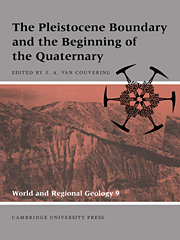Book contents
- Frontmatter
- Contents
- List of contributors
- Preface: the new Pleistocene
- Foreword
- Part I Definition of the base of the Quaternary
- Part II Characterization of the Pleistocene boundary-stratotype
- Part III The paleontological context of the Pleistocene boundary
- Part IV The Pleistocene boundary in regional sequences
- 11 The Pliocene–Pleistocene boundary in Italy
- 12 Stratigraphy of the Plio–Pleistocene sequence of the Mediterranean coastal belt of Israel and its implications for the evolution of the Nile Cone
- 13 The Pliocene–Pleistocene transition in the Iberian Peninsula
- 14 Biostratigraphy and calibrated climatic chronology of the Upper Pliocene and Lower Pleistocene of France
- 15 The Plio–Pleistocene of England and Iceland
- 16 The Neogene–Ouaternary boundary in The Netherlands
- 17 The Tertiary–Quaternary boundary in western Germany
- 18 The Pliocene–Pleistocene boundary in eastern Germany
- 19 The Plio–Pleistocene of Hungary
- 20 The Pliocene–Pleistocene boundary in Romania
- 21 The Pliocene and Pleistocene of the European part of the Commonwealth of Independent States
- 22 The N/Q boundary in Asian Russia and Tadjikistan
- 23 The Pliocene–Pleistocene boundary in the Indian subcontinent
- 24 The Pliocene–Pleistocene boundary in Japan: the Osaka Group, Kinki district
- 25 The Pliocene–Pleistocene boundary in Japan: stratigraphy in the Boso Peninsula, central Japan
- 26 The base of the Quaternary in China
- 27 Plio–Pleistocene deposits and the Quaternary boundary in sub-Saharan Africa
- 28 Plio–Pleistocene reference sections in Indonesia
- 29 The Pliocene–Pleistocene boundary in New Zealand
- 30 The Pliocene–Pleistocene boundary in continental sequences of North America
- Index
11 - The Pliocene–Pleistocene boundary in Italy
Published online by Cambridge University Press: 10 November 2009
- Frontmatter
- Contents
- List of contributors
- Preface: the new Pleistocene
- Foreword
- Part I Definition of the base of the Quaternary
- Part II Characterization of the Pleistocene boundary-stratotype
- Part III The paleontological context of the Pleistocene boundary
- Part IV The Pleistocene boundary in regional sequences
- 11 The Pliocene–Pleistocene boundary in Italy
- 12 Stratigraphy of the Plio–Pleistocene sequence of the Mediterranean coastal belt of Israel and its implications for the evolution of the Nile Cone
- 13 The Pliocene–Pleistocene transition in the Iberian Peninsula
- 14 Biostratigraphy and calibrated climatic chronology of the Upper Pliocene and Lower Pleistocene of France
- 15 The Plio–Pleistocene of England and Iceland
- 16 The Neogene–Ouaternary boundary in The Netherlands
- 17 The Tertiary–Quaternary boundary in western Germany
- 18 The Pliocene–Pleistocene boundary in eastern Germany
- 19 The Plio–Pleistocene of Hungary
- 20 The Pliocene–Pleistocene boundary in Romania
- 21 The Pliocene and Pleistocene of the European part of the Commonwealth of Independent States
- 22 The N/Q boundary in Asian Russia and Tadjikistan
- 23 The Pliocene–Pleistocene boundary in the Indian subcontinent
- 24 The Pliocene–Pleistocene boundary in Japan: the Osaka Group, Kinki district
- 25 The Pliocene–Pleistocene boundary in Japan: stratigraphy in the Boso Peninsula, central Japan
- 26 The base of the Quaternary in China
- 27 Plio–Pleistocene deposits and the Quaternary boundary in sub-Saharan Africa
- 28 Plio–Pleistocene reference sections in Indonesia
- 29 The Pliocene–Pleistocene boundary in New Zealand
- 30 The Pliocene–Pleistocene boundary in continental sequences of North America
- Index
Summary
Introduction
Italy is one of the primary sources of data for the Pliocene and Pleistocene. The Italian coastal margins were affected by tectonism during the Pleistocene more than any other part of western Europe, and as a result the Upper Cenozoic marine sequences that crop out along the coast in Sicily and in the mainland Apennine foothills (Figure 11.1) have been the subjects of classic studies on the chronostratigraphy of that age. Additionally, Plio–Pleistocene strata with stratigraphic thicknesses exceeding 8,000 m have been sampled in boreholes in the subsurface of the central Po Valley. Finally, Pliocene and Lower Pleistocene nonmarine strata are common in the montane basins of the Italian peninsula.
Since the very beginning of stratigraphy as a science, the abundance of Cenozoic fossils, particularly in the marine record, has attracted attention to the Italian sections. Lyell's original designations of the “older” and “younger” Pliocene (Lyell, 1833), the latter of which became the Pleistocene, relied heavily on the malacofaunas of the northern Apennines. For the same reason, all standard Pliocene and Pleistocene marine chronostratigraphic terms used in global correlation are based on the biostratigraphy of the Italian sequences. In recognition of this historical importance, the XVIII International Geological Congress in London in 1948 confirmed a general consensus that the Pliocene–Pleistocene boundary should be defined in the exposed Italian marine strata.
In this chapter we shall review the stratigraphic data available from the marine and continental records of Italy, as background for defining the Pliocene–Pleistocene boundary.
- Type
- Chapter
- Information
- The Pleistocene Boundary and the Beginning of the Quaternary , pp. 141 - 155Publisher: Cambridge University PressPrint publication year: 1996



